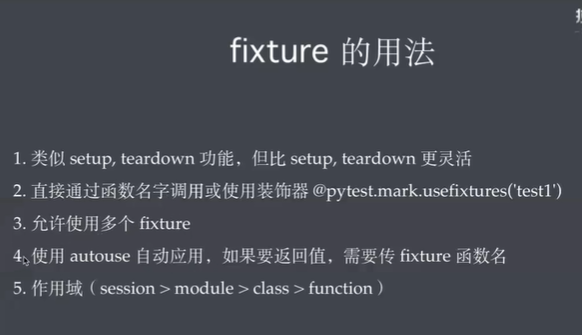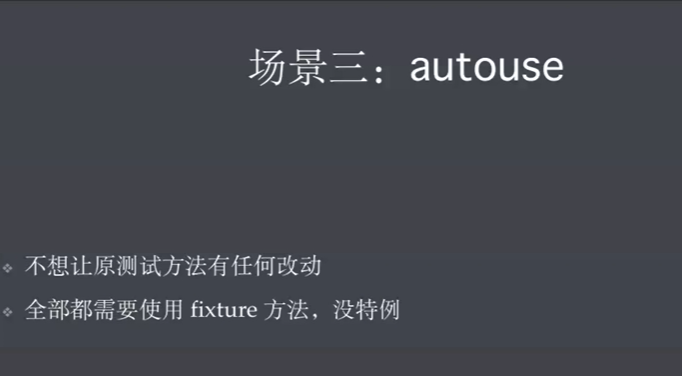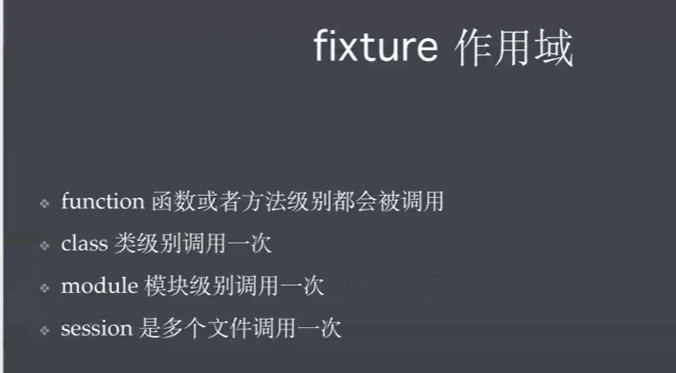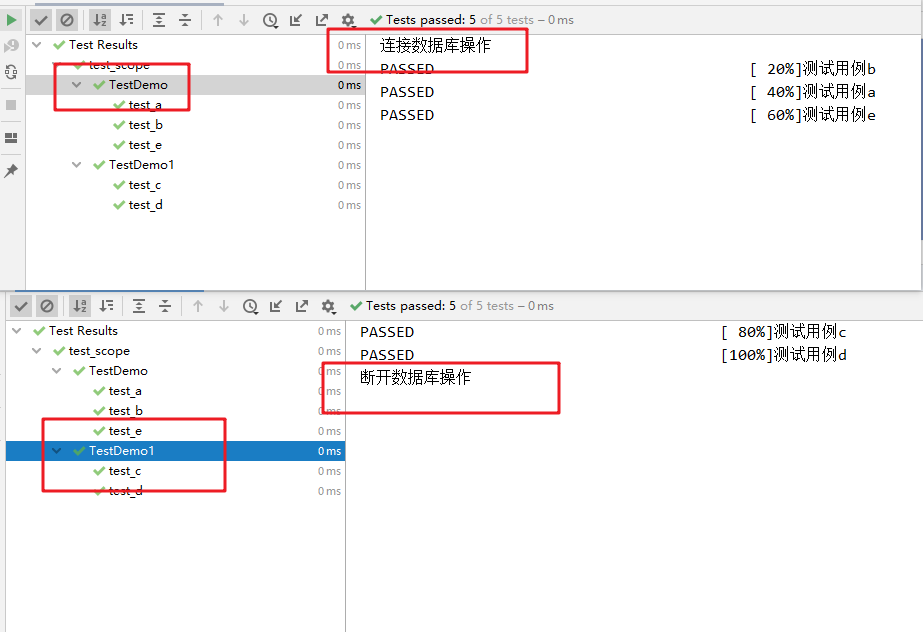###课程贴地址
https://ceshiren.com/t/topic/9916
fixture
调用方式
- 测试用例中传入 fixture 方法名
@pytest.mark.usefixtures("login")- 自动调用:
@pytest.fixture(autouse=True)
作用域
- 控制方法:
@pytest.fixture(scope='') - scope 的取值
- function
- class
- module
- session
fixture 方法返回值的获取
- 在测试用例中使用 fixture 方法名就可以获取到 yield 后面的返回值
作用:
定义传入测试中的数据集
配置测试前系统的初始状态
为批量测试提供数据源等

场景一:自动化中应用
测试用例执行时,有的用例需要登陆才能执行,有些用例不需要登录
setup 和teardown无法满足
#!/usr/bin/env python # -*-coding:utf-8 -*- # -*-hanjingjing-*- import pytest @pytest.fixture() def login(): print("登录操作") #测试用例1,需要提前登录 #在测试用例中传入fix方法名 def test_case1(login): print("测试用例1") def test_case2(): print("测试用例2") #测试用例3,需要提前登录 def test_case3(login): print("测试用例3") #测试用例4,需要提前登录 #用装饰器的方法,将函数名用字符串方式传入 @pytest.mark.usefixtures('login') def test_case4(): print("测试用例4")

注:
获取fixture 方法的返回值,直接调用fixture方法名
#!/usr/bin/env python # -*-coding:utf-8 -*- # -*-hanjingjing-*- import pytest @pytest.fixture() def login(): print("登录操作") print('获取 token') username = "tom" password = "123456" token = "tokerjdjdkkdiid" #yield关键字可以激活fixture的teardown功能 #yeild相当于ruturn,返回数据可以直接跟在yield后面 yield[username,password,token] print("注销操作") # 测试用例1需要登录操作 def test_case1(login): print(f"用户信息返回:{login}") print("这是测试用例1")

如果所用用例都需要调用“登录模块
则需要:autouse
@pytest.fixture(autouse= True)
#!/usr/bin/env python # -*-coding:utf-8 -*- # -*-hanjingjing-*- import pytest @pytest.fixture(autouse= True) def login(): print("登录操作") print('获取 token') username = "tom" password = "123456" token = "tokerjdjdkkdiid" #yield关键字可以激活fixture的teardown功能 #yeild相当于ruturn,返回数据可以直接跟在yield后面 yield[username,password,token] print("注销操作") # 测试用例1需要登录操作 def test_case1(login): print(f"用户信息返回:{login}") print("这是测试用例1") def test_case2(): print("这是测试用例2") # 测试用例3需要登录操作 def test_case3(login): print("这是测试用例3") #c测试用例4,用装饰器的方法 #方法名作为字符串的方式的传入 @pytest.mark.usefixtures("login") def test_case4(): print("这是测试用例41")

1)function
import pytest @pytest.fixture(scope='function') def connectDB(): print("连接数据库操作") yield print("断开数据库操作") class TestDemo: def test_a(self,connectDB): print("测试用例a") def test_b(self,connectDB): print("测试用例b") class TestDemo1: def test_c(self,connectDB): print("测试用例c") def test_d(self,connectDB): print("测试用例d")
输出结果
两个函数调用两次

2)class
一个类调一次
#!/usr/bin/env python # -*-coding:utf-8 -*- # -*-hanjingjing-*- import pytest @pytest.fixture(scope='class') def connectDB(): print("连接数据库操作") yield print("断开数据库操作") class TestDemo: def test_a(self,connectDB): print("测试用例a") def test_b(self,connectDB): print("测试用例b") def test_a(self,connectDB): print("测试用例a") def test_e(self,connectDB): print("测试用例e") class TestDemo1: def test_c(self,connectDB): print("测试用例c") def test_d(self,connectDB): print("测试用例d")
输出结果

3)module
整个文件调用一下
#!/usr/bin/env python # -*-coding:utf-8 -*- # -*-hanjingjing-*- import pytest @pytest.fixture(scope='module') def connectDB(): print("连接数据库操作") yield print("断开数据库操作") class TestDemo: def test_a(self,connectDB): print("测试用例a") def test_b(self,connectDB): print("测试用例b") def test_a(self,connectDB): print("测试用例a") def test_e(self,connectDB): print("测试用例e") class TestDemo1: def test_c(self,connectDB): print("测试用例c") def test_d(self,connectDB): print("测试用例d")
输出结果
